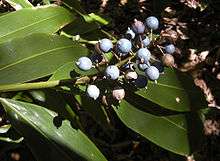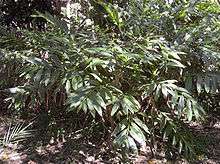Alpinia caerulea
| Alpinia caerulea | |
|---|---|
 | |
| Scientific classification | |
| Kingdom: | Plantae |
| (unranked): | Angiosperms |
| (unranked): | Monocots |
| (unranked): | Commelinids |
| Order: | Zingiberales |
| Family: | Zingiberaceae |
| Subfamily: | Alpinioideae |
| Tribe: | Alpinieae |
| Genus: | Alpinia |
| Species: | A. caerulea |
| Binomial name | |
| Alpinia caerulea (R.Br.) Benth. | |
| Synonyms[1] | |
| |
Alpinia caerulea, native ginger, is an understorey perennial herb to 3 m, growing under rainforest, gallery forest and wet sclerophyll forest canopy in eastern Australia.
Leaves are up to 40 cm long and 3–10 cm wide. The inflorescence is 10–30 cm long. [2] The blue capsule is globose 1 cm across, with a brittle outer covering containing black seed and white pulp.
Uses

The white pulp of native ginger has a sour flavour, used to activate salivary glands to moisten the mouth when bushwalking, with the seeds usually being discarded. The capsules can also be used as a flavouring spice, using the whole fruit and seed dried and ground. They can also be used to impart a sour flavour and red color in herbal teas.
The centers of new shoots have mild gingery flavour, and are excellent in various dishes as a ginger substitute. The roots can also be used in cooking, and have a more earthy resinous flavour.
References
- ↑ "The Plant List: A Working List of All Plant Species". Retrieved 20 February 2015.
- ↑ PlantNET, Alpinia caerulea plant profile